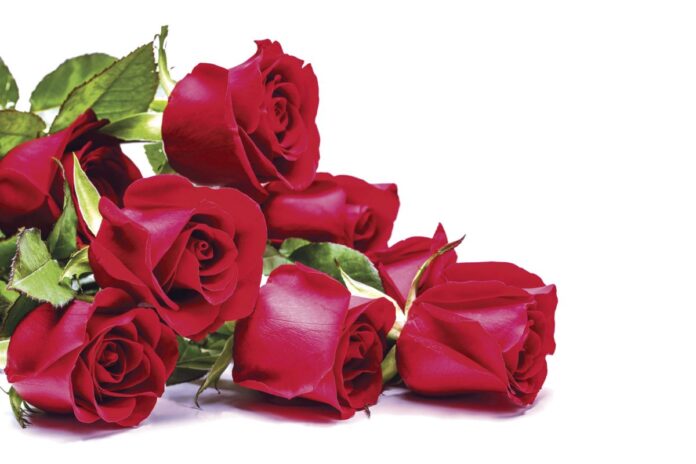BY LORI MURRAY
I recently began paging through a beautiful coffee table volume about roses and found some delightful information related to their history of which this is only a sample.
We all know that roses have been around for a long time, but just HOW long is amazing. And their impact on our history and leaders is still quite noticeable even after all these centuries.
In art, the earliest known painting of a rose dates back to the 16th century BC in Crete, and roses have been found in some Egyptian hieroglyphics and tombs. Decorations that resembled roses were found in the ruins of the ancient civilizations of Assyria and Babylonia in the area of today’s Iraq. In literature, the poet Homer of Iliad and Odyssey fame described the goddess who personifies the sunrise as “rosy-fingered Dawn.”
Omar Kayyam wrote of the rose in the “Rubaiyat” and Hafiz, a 14th century author, wrote wistfully, “O Love, the very perfume of the rose.” Centuries later Shakespeare himself mentions roses more than sixty times, his most famous perhaps in Romeo and Juliet when Juliet muses, “What’s in a name? That which we call a rose/ By any other name would smell as sweet.”
The earliest Christians shunned the rose because it reminded them of pagan Rome, but before too long the rose was incorporated into their religion. They chose the white rose to symbolize the Virgin Mary and gave the flower’s name to the rosary. whose early beads were made of rose hips. The fourth Sunday in Lent is known to Catholics as Laetare Sunday or Rose Sunday.
The vestments are rose-colored as a sign of the joy and hope to come on Easter Sunday. When Bernadette saw the Virgin Mary in the grotto at Lourdes, she described her as having golden roses at her feet. The rose’s petaled shape lends itself to the magnificent stained glass windows in cathedrals all over the world, the idea probably brought back by Crusaders who had seen the mosque of Ibn Touloun in Cairo.
Roses were used in medicine long before Christ. An herbal tome about the medicinal properties of plants included several references to rose petals and rose hips. The Dog Rose, rosa canina, was thought to be a cure for rabies. Even in the Middle Ages, doctors prescribed a hot mixture of crushed rose petals and peppercorns for a sore throat. (What doesn’t kill you makes you stronger?)
Many leaders have been associated with roses. King Midas and Alexander the Great are said to have grown roses. Herodites even wrote about Midas’ gardens in the 5th century BC. George Washington had roses at Mount Vernon and Jefferson grew them at Monticello.
In 1913, Woodrow Wilson’s wife made the area outside his office into a formal rose garden. And roses have certainly been named for famous people and events. Presidents Kennedy, Hoover and Lincoln as well as first ladies Lady Bird Johnson, Rosalynn Carter, Pat Nixon, and Nancy Reagan have all had roses named after them. The wandering troubadors of the middle ages sang of the rose and of love. A rose society in New York has roses named for songs as one of its competitions. Roses have been named for Bing Crosby, Dolly Parton, Minnie Pearl, the Ink Spots, and Patsy Kline.
Men have been preoccupied with roses for centuries and have even created legends to show the connection between roses and some occasion, event, or person. An ancient legend says that roses were born from the tears Venus shed at the death of Adonis. There are also legends from the time of Christ. One says the rose grew on the tree on which Judas hanged himself as a sign that the blood of Christ had been shed for sinners.
Another links the rose to the crown of thorns saying that the roses formed from the blood that flowed around the crown. And there are many festivals. The year begins for many of us with the famous Tournament of Roses (Rose Bowl) Parade. One of the largest festivals in the country takes place in Portland, Oregon, which is known as the “City of Roses.” The downtown turns into a street festival for 17 days in June with concerts and races and even the arrival of the Pacific Fleet.
As the crowning glory, the Rose Queen and her court lead a parade – second only to the Tournament of Roses Parade – to the Portland Rose Festival In September, two leading rose producing areas of the country have their own celebrations and feasts. One of them is held close to home in Tyler, Texas, the home of football great Earl Campbell who was of course nicknamed The Tyler Rose.
SOURCE: The Rose by Ann Reilly. New York: Portland House, 1989.




